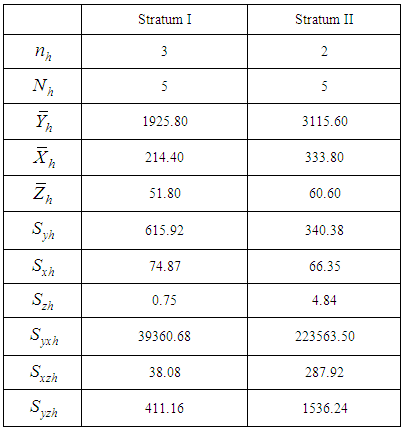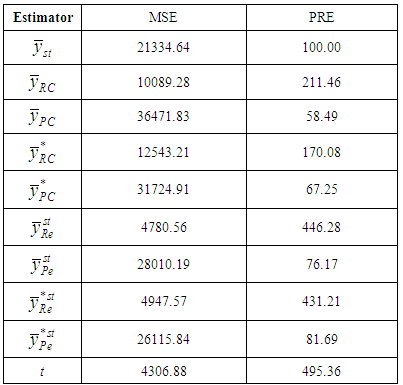-
Paper Information
- Paper Submission
-
Journal Information
- About This Journal
- Editorial Board
- Current Issue
- Archive
- Author Guidelines
- Contact Us
American Journal of Operational Research
p-ISSN: 2324-6537 e-ISSN: 2324-6545
2015; 5(4): 75-81
doi:10.5923/j.ajor.20150504.01
Searching Efficient Estimator of Population Mean in Stratified Random Sampling
Subhash Kumar Yadav 1, Sheela Misra 2, S. S. Mishra 1, Alok Kumar Shukla 3
1Department of Mathematics and Statistics (A Centre of Excellence), Dr. RML Avadh University, Faizabad, U.P., India
2Department of Statistics, University of Lucknow, Lucknow, U.P., India
3Department of Statistics, D.A-V College, Kanpur, U.P., India
Correspondence to: S. S. Mishra , Department of Mathematics and Statistics (A Centre of Excellence), Dr. RML Avadh University, Faizabad, U.P., India.
| Email: |  |
Copyright © 2015 Scientific & Academic Publishing. All Rights Reserved.
In the article, we propose an improved dual to ratio cum dual to product estimator of the population mean under the stratified random sampling scheme. The expressions for the bias and mean squared error (MSE) of the proposed estimator are found by the first degree of approximation. The optimum value of the constant, which minimizes the MSE of the proposed estimator, is also obtained. Efficiency comparisons are performed between the proposed estimator and many estimators in Literature under the stratified random sampling and the efficiency conditions of the proposed estimator are determined. Finally, an empirical study is carried out which shows the performance of the proposed estimator along with the existing estimators under the stratified random sampling.
Keywords: Ratio and Product estimators, Stratified Random Sampling, Bias, MSE, Efficiency
Cite this paper: Subhash Kumar Yadav , Sheela Misra , S. S. Mishra , Alok Kumar Shukla , Searching Efficient Estimator of Population Mean in Stratified Random Sampling, American Journal of Operational Research, Vol. 5 No. 4, 2015, pp. 75-81. doi: 10.5923/j.ajor.20150504.01.
Article Outline
1. Introduction
- In practice, it is very common that the use of the auxiliary variable (x or z) improves the efficiency of the estimators for the population parameters of the study variable (y). The auxiliary information supplied by the auxiliary variables is used both at the design and estimation stages of the survey. We have used it in the estimation stage in this article. The auxiliary variable is highly correlated (positively or negatively) with the study variable. The ratio method of estimation providing ratio type estimators is used for the estimation of population parameters when the study variable and the auxiliary variables are highly positively correlated to each other; whereas, the product method of estimation giving product type estimators is used when y and x are highly negatively correlated to each other. As in practice, we find that the study variable has both positive and negative correlations with two different variables at a time. This encourages us to use both positively and negatively correlated variables in our study and we propose the dual to ratio and dual to product estimator of the population mean in the stratified random sampling. The improvement is a continuous process of research and the form of the estimator using the scalar
 has always improved the estimators of population parameters in the simple random sampling. Being inspired from this truth, we have proposed the dual to ratio and dual to product estimator of the population mean in the stratified random sampling.As we deal with the methods in the stratified random sampling, assume that the finite population,
has always improved the estimators of population parameters in the simple random sampling. Being inspired from this truth, we have proposed the dual to ratio and dual to product estimator of the population mean in the stratified random sampling.As we deal with the methods in the stratified random sampling, assume that the finite population,  , consists of
, consists of  distinct and identifiable units which are heterogeneous from each other. Let the whole population be divided into
distinct and identifiable units which are heterogeneous from each other. Let the whole population be divided into  strata of sizes,
strata of sizes,  , in which units are relatively homogeneous to each other. In addition, the study variable, y, and two auxiliary variables, x and z, take the values
, in which units are relatively homogeneous to each other. In addition, the study variable, y, and two auxiliary variables, x and z, take the values and
and 
 , respectively, for the
, respectively, for the  unit of the
unit of the  stratum. It is clear that the sub-samples of sizes,
stratum. It is clear that the sub-samples of sizes,  , are drawn from each stratum using the proportional allocation method, constituting of the required sample of size as
, are drawn from each stratum using the proportional allocation method, constituting of the required sample of size as  .Following common notations of the stratified random sampling can be given by
.Following common notations of the stratified random sampling can be given by  : The
: The  stratum population mean for the study variable,
stratum population mean for the study variable,  ,
, : The
: The  stratum population mean for the auxiliary variable,
stratum population mean for the auxiliary variable,  ,
, : The
: The  stratum population mean for the auxiliary variable,
stratum population mean for the auxiliary variable,  ,
, : The population mean of the study variable,
: The population mean of the study variable,  ,
, : The population mean of the auxiliary variable,
: The population mean of the auxiliary variable,  ,
, : The population mean of the auxiliary variable,
: The population mean of the auxiliary variable,  ,
, : The
: The  stratum sample mean of the study variable,
stratum sample mean of the study variable,  ,
,  : The
: The  stratum sample mean of the auxiliary variable,
stratum sample mean of the auxiliary variable,  ,
,  : The
: The  stratum sample mean of the auxiliary variable,
stratum sample mean of the auxiliary variable,  ,
,  : Weight of the
: Weight of the  stratum.
stratum.2. Estimators in Literature
- Hansen et al. (1946) proposed the classical combined ratio estimator for the population mean under the stratified random sampling as
 | (2.1) |
 and
and  .The MSE of the combined ratio estimator in (2.1), up to the first order of approximation, is
.The MSE of the combined ratio estimator in (2.1), up to the first order of approximation, is | (2.2) |
 ,
,  is the population ratio,
is the population ratio,  is the population variance of the study variable,
is the population variance of the study variable,  is the population variance of the auxiliary variable, and
is the population variance of the auxiliary variable, and  is the population covariance between the study and auxiliary variables in the
is the population covariance between the study and auxiliary variables in the  stratum.The combined product estimator of the population mean in the stratified random sampling is defined as
stratum.The combined product estimator of the population mean in the stratified random sampling is defined as | (2.3) |
 .The MSE of the combined product estimator in (2.3), up to the first order of approximation, is
.The MSE of the combined product estimator in (2.3), up to the first order of approximation, is | (2.4) |
 .Many authors, such as Kadilar and Cingi (2003; 2005), Shabbir and Gupta (2006), Singh and Vishwakarma (2008), Koyuncu and Kadilar (2009a; 2009b; 2010a; 2010b), Sanaullah et al. (2014), Mouhamed et al. (2015), Yadav et al. (2015a, 2015b), Onyeka et al. (2015) improve the ratio and product estimators, given in (2.1) and (2.3), for the population mean of the study variable in the stratified random sampling. However, in this article, we examine only dual estimators for the population mean in Literature that can be summarized as follows:Using the combined ratio and product estimators, Kushwaha et al. (1990) proposed the following dual to ratio and dual to product estimators by the Srivenkataramana (1980) transformation as
.Many authors, such as Kadilar and Cingi (2003; 2005), Shabbir and Gupta (2006), Singh and Vishwakarma (2008), Koyuncu and Kadilar (2009a; 2009b; 2010a; 2010b), Sanaullah et al. (2014), Mouhamed et al. (2015), Yadav et al. (2015a, 2015b), Onyeka et al. (2015) improve the ratio and product estimators, given in (2.1) and (2.3), for the population mean of the study variable in the stratified random sampling. However, in this article, we examine only dual estimators for the population mean in Literature that can be summarized as follows:Using the combined ratio and product estimators, Kushwaha et al. (1990) proposed the following dual to ratio and dual to product estimators by the Srivenkataramana (1980) transformation as | (2.5) |
 | (2.6) |
 and
and  . Here, the Srivenkataramana (1980) transformations are
. Here, the Srivenkataramana (1980) transformations are  and
and  .The MSE of dual to ratio and dual to product estimators in (2.5) and (2.6), respectively, up to the first order of approximation, are, respectively, given by
.The MSE of dual to ratio and dual to product estimators in (2.5) and (2.6), respectively, up to the first order of approximation, are, respectively, given by | (2.7) |
 | (2.8) |
 .Singh et al. (2008) suggested following exponential ratio and product type estimators in the stratified random sampling based on Bahl and Tuteja (1991) estimators of the population mean under the simple random sampling, respectively, as follows:
.Singh et al. (2008) suggested following exponential ratio and product type estimators in the stratified random sampling based on Bahl and Tuteja (1991) estimators of the population mean under the simple random sampling, respectively, as follows: | (2.9) |
 | (2.10) |
 | (2.11) |
 | (2.12) |
 | (2.13) |
 | (2.14) |
 | (2.15) |
 | (2.16) |
3. Proposed Estimator
- Motivated by the estimators, mentioned in Section 2 and the fact that the use of a scalar in the current forms (2.13) and (2.14) always improves the estimator, we propose the following dual to ratio cum dual to product estimator of the population mean in the stratified random sampling by combining the dual to ratio and dual to product estimators as
 | (3.1) |
 is a suitable constant to be determined such that the MSE of the proposed estimator,
is a suitable constant to be determined such that the MSE of the proposed estimator,  , is minimum.It is worth notable that it becomes the dual to product estimator, given in (2.14), for
, is minimum.It is worth notable that it becomes the dual to product estimator, given in (2.14), for  and that it reduces to dual to ratio estimator, given in (2.13), for
and that it reduces to dual to ratio estimator, given in (2.13), for  .To study the large sample properties of the proposed estimator,
.To study the large sample properties of the proposed estimator,  , let us define the following notations:
, let us define the following notations: ,
,  , and
, and  such that
such that  and
and  ,
,  ,
,  ,
,  ,
,  ,
,  .Expressing the proposed estimator, in (3.1), in terms of
.Expressing the proposed estimator, in (3.1), in terms of  , we have
, we have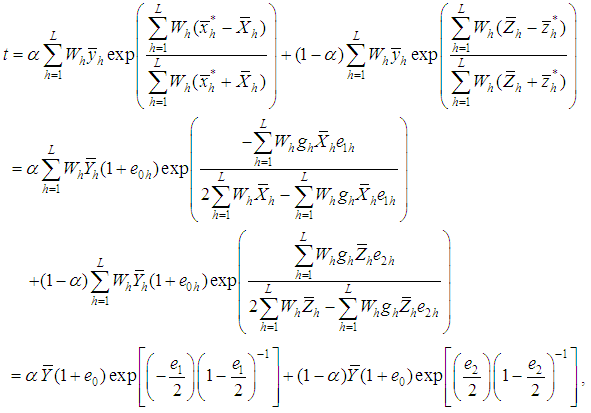 | (3.2) |
 , and
, and  such that
such that  and
and  ,
,  ,
,  ,
,  ,
,  ,
,  .On simplifying the expressions after the expansion on the right hand side of (3.2), up to the first order of approximation, we have
.On simplifying the expressions after the expansion on the right hand side of (3.2), up to the first order of approximation, we have | (3.3) |
 | (3.4) |
 | (3.5) |
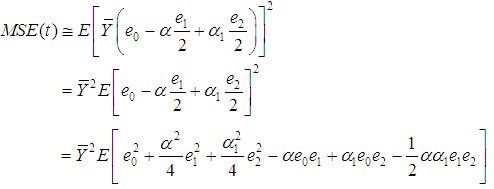 | (3.6) |
 where
where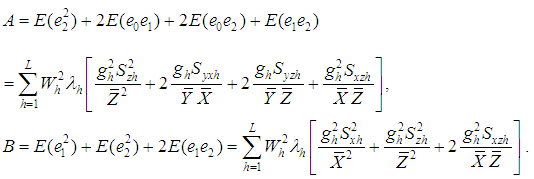 Finally, the minimum MSE of the proposed estimator is
Finally, the minimum MSE of the proposed estimator is | (3.7) |
4. Efficiency Comparisons
- The variance of the sample mean in the stratified random sampling,
 , is given by
, is given by | (4.1) |
 , and
, and  , respectively.The proposed estimator,
, respectively.The proposed estimator,  , is more efficient than
, is more efficient than  if
if | (4.2) |
 , if
, if | (4.3) |
 , if
, if | (4.4) |
 , if
, if | (4.5) |
 , if
, if | (4.6) |
 is more efficient than
is more efficient than  if
if | (4.7) |
 is more efficient than
is more efficient than  if
if | (4.8) |
 , is more efficient than
, is more efficient than  if
if | (4.9) |
 , is more efficient than
, is more efficient than  if
if | (4.10) |
5. Empirical Study
- To examine the efficiency of the proposed estimator over other estimators, we consider the data set in Murthy (1967) whose statistics are given in Table 1. The MSE and percent relative efficiency (PRE) values are given in Table 2.
|

|
6. Conclusions
- Sample surveys are legitimately considered as cost effective apparatus for estimation of the population parameter. The Statistician wishes to minimize the mean square error of the estimator to ideally infer about the parameter of the given population. In the present problem, we have made the comparisons of desired results with previous researchers. From the theoretical discussion and the numerical results from Table 2, we conclude that the proposed estimator is better than the mentioned estimators, in Section 2, under the stratified random sampling scheme as the proposed estimator has smaller mean squared error. By this numerical example, we also show that the efficiency conditions in theory for the proposed estimator, obtained in (4.2)-(4.10), are satisfied in practice, as well. Thus, the proposed estimator should be preferred for the estimation of the population mean under the stratified random sampling.
 Abstract
Abstract Reference
Reference Full-Text PDF
Full-Text PDF Full-text HTML
Full-text HTML